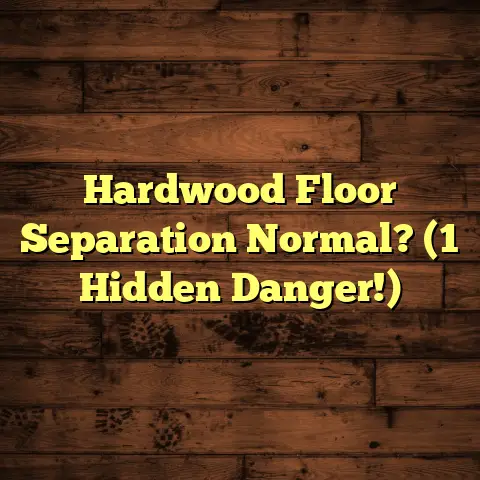Laminate Over Hardwood? Underlayment Needed? (1 Mistake!)
Think back for a moment.
Remember those cozy family dinners around the dining table? Or the kids sprawled out on the living room floor, building Lego castles?
Those memories, those warm, fuzzy feelings, are often tied to the heart of our home—and more often than not, that heart is floored with, well, flooring!
Every scratch, every mark, tells a story.
And for many of us, that story is etched into the timeless beauty of hardwood.
But here’s the rub: life happens.
Kids, pets, budgets, changing styles…
Suddenly, the idea of covering that beloved hardwood with laminate starts to creep in.
It’s a tough decision, right?
Hiding the character and warmth of real wood for something that might seem more practical or aesthetically “now.”
I get it. I’ve been there, seen it, and helped countless homeowners wrestle with this very dilemma.
Let’s dive into the world of flooring, and I’ll share some insights I’ve picked up over the years.
Section 1: The Allure of Laminate Flooring
Laminate flooring has exploded in popularity, and for good reason.
It’s generally more affordable than hardwood, easier to install (think click-and-lock systems!), and comes in a dizzying array of styles and colors.
You can mimic the look of almost any wood species, stone, or even tile!
But the real draw for many homeowners is durability.
Laminate is designed to withstand the daily onslaught of kids, pets, and clumsy adults.
It’s resistant to scratches, stains, and fading, making it a seemingly perfect solution for busy households.
I’ve seen families with young children and energetic dogs breathe a sigh of relief at the thought of a floor that can handle anything they throw at it (literally!).
However, I’ve also seen homeowners who, initially thrilled with their laminate floors, later regret their decision.
They miss the warmth and character of real wood.
They realize the “feel” underfoot just isn’t the same.
And sometimes, they encounter problems they didn’t anticipate.
Section 2: Understanding Hardwood Flooring
Hardwood flooring is a classic for a reason.
It’s beautiful, durable (when properly cared for), and adds real value to your home.
Think about the different types: oak, maple, cherry, walnut… each with its own unique grain pattern, color variation, and personality.
Oak, for example, is a popular choice for its durability and versatility.
Maple offers a cleaner, more modern look.
Cherry brings a touch of elegance and warmth.
Beyond the species, you’ve got different textures and finishes to consider.
Smooth, hand-scraped, wire-brushed… the possibilities are endless.
But hardwood is more than just a material; it’s an emotional investment.
It’s about the connection to nature, the timelessness of the design, and the sense of pride that comes with owning something of quality.
I’ve worked with homeowners who have inherited hardwood floors from previous generations.
They cherish those floors, seeing them as a link to their family history.
They’re willing to invest the time and effort to maintain them, knowing that they’re preserving something special.
Section 3: The Decision-Making Process
So, why would anyone consider covering up beautiful hardwood with laminate?
The reasons are varied, but they often boil down to these factors:
-
Budget Constraints: Laminate is generally less expensive than hardwood, both in terms of materials and installation.
-
Lifestyle Changes: Young children or pets might make homeowners worry about the vulnerability of hardwood to scratches and stains.
-
Desire for a Quick Renovation: Laminate installation is often faster and easier than refinishing or replacing hardwood.
There’s also a psychological aspect to consider.
Home improvement decisions are often driven by a mix of emotions:
-
Fear of Making a Mistake: No one wants to invest in a renovation that they’ll later regret.
-
Desire for Transformation: We all want our homes to reflect our personal style and meet our current needs.
-
Quest for Comfort: Ultimately, we want our homes to be comfortable, functional, and enjoyable.
Now, let’s talk about underlayment.
This is where things get interesting, and where many homeowners make a critical mistake.
Underlayment is a thin layer of material that’s installed between the subfloor and the laminate flooring.
It serves several important functions, which we’ll discuss in more detail in the next section.
But for now, just keep in mind that underlayment is not optional.
It’s an essential part of the laminate flooring system, and choosing the right underlayment (or failing to use it altogether) can have a huge impact on the performance and longevity of your new floor.
Section 4: The Importance of Underlayment
Okay, so what exactly does underlayment do?
Think of it as the unsung hero of your laminate floor.
It provides a number of crucial benefits:
-
Soundproofing: Underlayment helps to absorb sound, reducing noise transmission between floors and rooms. This is especially important in multi-story homes or apartments.
-
Moisture Barrier: Many underlayments include a moisture barrier that protects the laminate from moisture rising from the subfloor. This is critical for preventing warping and other moisture-related problems.
-
Cushioning: Underlayment provides a layer of cushioning underfoot, making the floor more comfortable to walk on. It can also help to even out minor imperfections in the subfloor.
-
Support: It provides support for the laminate planks, reducing flexing and movement that can lead to premature wear and tear.
Proper installation of underlayment can significantly enhance the performance and longevity of your laminate floor, creating a more comfortable and enjoyable living environment.
I’ve seen countless cases where homeowners neglected underlayment (or used the wrong type of underlayment) and ended up with a host of problems:
-
Noisy Floors: Every step sounds like a drum solo.
-
Uneven Surfaces: Bumps and dips make the floor feel uncomfortable and unstable.
-
Moisture Damage: Warping, buckling, and mold growth.
-
Premature Wear: The laminate wears out much faster than it should.
Don’t let this happen to you!
Choosing the right underlayment is just as important as choosing the right laminate.
Section 5: The One Mistake
Alright, let’s get to the heart of the matter.
The one critical mistake that many homeowners make when installing laminate over hardwood is…
Failing to use the correct underlayment!
I know, it sounds simple, but it’s a mistake with serious repercussions.
You might be thinking, “But wait, isn’t hardwood already a solid, stable surface? Do I really need underlayment?”
The answer is a resounding YES!
Even though hardwood provides a relatively smooth and even subfloor, it doesn’t address the other critical functions of underlayment: sound absorption, moisture protection, and cushioning.
And here’s the kicker: using the wrong underlayment can actually be worse than using none at all.
For example, if you use an underlayment that’s too thick or too soft, it can create too much flex under the laminate, leading to joint separation and premature wear.
Or, if you use an underlayment that doesn’t breathe properly, it can trap moisture between the laminate and the hardwood, creating a breeding ground for mold and mildew.
I’ve seen it happen time and time again.
Homeowners try to save a few bucks by skipping the underlayment or using a cheap, generic product, only to end up paying the price later on.
Imagine this scenario:
You’ve spent weeks researching different laminate styles, carefully selecting the perfect color and texture to match your décor.
You’ve spent hours installing the floor yourself, meticulously clicking each plank into place.
You’re finally finished, and you step back to admire your handiwork.
It looks great!
But then you take a few steps, and you hear it:
A hollow, echoing sound with every footstep.
The floor feels hard and unforgiving underfoot.
And you start to notice a slight musty smell in the air.
That’s when the sinking feeling sets in.
You realize you’ve made a mistake.
A costly mistake.
Section 6: The Consequences of Overlooking
Underlayment
So, what are the potential problems that can arise from improper underlayment installation?
Let’s break it down:
-
Moisture-Related Issues: As mentioned earlier, moisture is a major enemy of laminate flooring. Without a proper moisture barrier, moisture can seep up from the subfloor, causing the laminate to warp, buckle, and even grow mold. This can lead to costly repairs and potential health problems.
-
Discomfort Underfoot: Laminate flooring installed directly over hardwood without underlayment can feel hard and cold underfoot. This can be especially noticeable in colder climates or in rooms with concrete subfloors.
-
Increased Noise Levels: Without the sound-absorbing properties of underlayment, laminate flooring can be quite noisy to walk on. This can be disruptive to other members of the household, especially in multi-story homes.
-
Shortened Lifespan of the Laminate Flooring: Improper installation can significantly reduce the lifespan of your laminate floor. The constant flexing and movement can cause the joints to weaken and break, leading to premature wear and tear.
-
Voiding the Warranty: Many laminate flooring manufacturers require the use of a specific type of underlayment in order to maintain the warranty. If you don’t follow their recommendations, you could be left without recourse if something goes wrong.
I remember one homeowner who contacted me after installing laminate over hardwood without underlayment.
She had followed a DIY tutorial online that claimed underlayment wasn’t necessary.
Within a few months, she started to notice warping and buckling in several areas of the floor.
She contacted the laminate manufacturer, but they refused to honor the warranty because she hadn’t used the recommended underlayment.
She ended up having to replace the entire floor, at a cost of several thousand dollars.
It was a heartbreaking situation, and it could have been easily avoided with a little bit of knowledge and planning.
Beyond the immediate costs of repair or replacement, improper flooring installation can also affect your property value.
A poorly installed floor can detract from the overall appearance of your home and make it more difficult to sell.
Potential buyers may be turned off by the sight of warped, buckled, or noisy floors.
Section 7: Conclusion
We’ve covered a lot of ground here, from the allure of laminate to the timeless beauty of hardwood, and the critical importance of underlayment.
The decision to cover hardwood with laminate is a personal one, and there’s no right or wrong answer.
But it’s essential to make an informed decision, weighing the pros and cons carefully and considering the long-term implications.
Don’t let the desire for a quick and easy renovation cloud your judgment.
Take the time to do your research, consult with professionals, and choose the right materials and installation methods.
And whatever you do, don’t underestimate the importance of underlayment!
It’s a small investment that can make a big difference in the performance, longevity, and overall enjoyment of your new floor.
As a flooring contractor, I’ve seen firsthand the emotional and financial ramifications of neglecting key aspects like underlayment.
I’ve seen homeowners thrilled with their new floors, and I’ve seen homeowners devastated by costly mistakes.
My goal is to help you make the right choices for your home, so you can enjoy beautiful, durable floors for years to come.
So, take a moment to reflect on your own flooring choices.
Think about the stories your floors tell, and the memories they hold.
Cherish your home, and make thoughtful renovation choices that will enhance its beauty, comfort, and value.
And remember, sometimes the best decisions are the ones that seem the least obvious at first.
Thanks for reading, and happy flooring!





